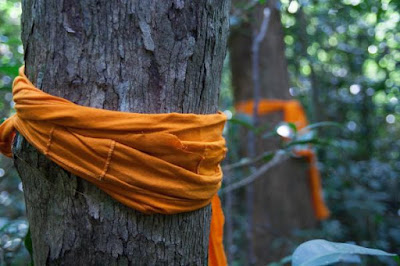August Rick (Sojourners, sojo.net, 10/11/18); Ellie Askew, Dhr. Seven (ed.), Wisdom Quarterly
To protect the environment, Buddhist monks sometimes ordain trees
Buddhism began in the forest as a forest tradition
Traveling from several provinces across the heavily logged Cambodian landscape, two dozen Buddhist monks met at a local pagoda to attend a workshop held by the Alliance of Religions and Conservation (ARC).
For Cambodia’s emerging network of “ecology monks” working in an increasingly authoritarian climate, the meeting was a critical and rare opportunity to discuss best practices for local forest conservation projects. Then two cops showed up and shut it down.
“They’re very wary of the monks getting together,” Chantal Elkin, a program manager for ARC, told Sojourners. “Forest activism is [seen as] a threat to the government.”
Several monks were visibly upset, Elkin said.
Though traditionally revered in Cambodia’s majority-Theravada Buddhist society, monks and maechis (ten precept nuns) today are not immune to the government’s violent crackdown on civil society actors.
But where efforts at civic organization meet rebuke, Cambodia has seen the rise of one act of conservation — the Buddhist ordination of trees — which originally emerged in Thailand and has gained a foothold in Buddhist monastic practice.
The elder monk in the group took the two officers, local cops not antagonistic to the meeting but seemingly just following orders, up the hill where the group ordained a tree into the Buddhist sangha (spiritual community) then dispersed.
Beginning in the late 1980s, Thai Forest Tradition (thudong or dhutanga) monks began to "ordain" trees just as they would induct a human. [The effort is to preserve the trees, which locals fear cutting down, just as they would fear harming a monk.]
 |
| Yellow Shirt police state? Red Shirts: "No way!" |
Though the practice varies, it is understood across the board to be an effort to alleviate suffering, a core ideal of Buddhist practice. More
COMMENTARY
- Can a tree become a monastic? Who's to say? Probably not, but what about the tree spirit or dryad? A woodland sprite or bhumi-deva might be able to keep the necessary precepts of a monk or nun.
- Nevertheless, using the respect local people have for monastics keeps trees from getting chopped down.
- In this way the forest (environment) and the people (community) are saved. Sometimes there's no other way to awaken people to their own enlightened self-interest of foregoing some personal profit in selling timber for the greater good of the community by having a thriving forest of food, medicine, and climate-saving trees.
- Trees, if they did nothing else, prevent erosion, keeping the fertile topsoil in place. Once it's lost, nothing grows and synthetic chemicals get trucked in, or land is converted to harmful ranching or just washes away.
- Trees do far more than stop erosion, and they are hard to replace. Not any tree will do. A noninvasive indigenous species is needed.
- Ecosystems are complex and very delicate. Science hardly understands how even the simplest one actually works.
- So save the trees, save the people, save the country and the future of human and deva life on this planet.





















































































































































































































































No comments:
Post a Comment